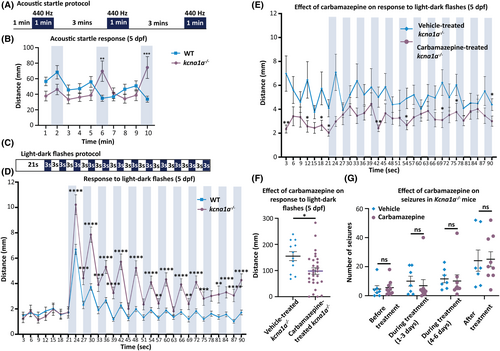Fig. 3
- ID
- ZDB-FIG-231208-18
- Publication
- Dogra et al., 2023 - kcna1a mutant zebrafish model episodic ataxia type 1 (EA1) with epilepsy and respond to first-line therapy carbamazepine
- Other Figures
- All Figure Page
- Back to All Figure Page
|
Analysis of startle response in kcna1a−/− zebrafish and effect of carbamazepine treatment on kcna1a−/− zebrafish and Kcna1a−/− mice. (A) Schematic representation of acoustic startle protocol. (B) Quantification of distance traveled every 1 min in acoustic startle at 5 dpf. kcna1a−/− are more responsive to startle with significantly higher distance traveled in second and third vibration pulse compared to WT. WT, n = 113; kcna1a−/−, n = 52. (C) Schematic representation of light–dark flashes protocol. (D) Quantification of distance traveled every 3 s in light–dark flashes at 5 dpf. kcna1a−/− show higher sensitivity to startle with more distance traveled compared to WT. WT, n = 108; kcna1a−/−, n = 63. (E, F) Quantification of distance traveled every 3 s (E) and in 90 s (F) in light–dark flashes after treatment with carbamazepine at 5 dpf. Carbamazepine treatment rescues impaired startle response in kcna1a−/−. Vehicle-treated kcna1a−/−, n = 12; carbamazepine-treated kcna1a−/−, n = 29. (G) Quantification of number of seizures encountered by vehicle- and carbamazepine-treated P36-38 Kcna1a−/− mice at different time points. Carbamazepine treatment does not reduce the frequency of seizures in Kcna1a−/− mice. Vehicle-treated Kcna1a−/−, n = 7; carbamazepine-treated Kcna1a−/−, n = 9. Data are mean ± SEM, ns: no significant changes observed, *p ≤ .05, **p ≤ .01, ***p ≤ .001, ****p ≤ .0001- Unpaired t test. |

